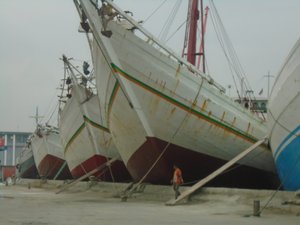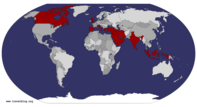Advertisement
Published: March 10th 2016

 Jakarta
Jakarta
Sundakelpa HarbourJakarta, Java, Indonesia Feb. 20
Indonesia is the largest archipelago in the world, comprising 13,667 islands.
Tanjun Priok is the port for Jakarta, the capital of Indonesia and our first stop in the storied archipelago. Historically dominated mostly by the Dutch trading empire, and during WWII, by the Japanese, it is known for its extensive shopping opportunities, so the unadventurous or materially needy filed off to the shuttle bus to be delivered to the many small shops, flea markets, supermarkets and department stores.
Guide Jojo and driver "Mr. Harris" did well, getting us downtown and around central Jakarta on a Saturday.from 7:30am to about 1pm, getting us back in plenty of time. This happened in spite of pessimistic predictions of absolutely insane traffic and unpredictable gridlock. In the actual event it was bad, but no worse than Athens.
This is not a pretty city. Historically it is full of conflict, strife, domination and fights for human rights and for independence. The Dutch colonial influence is widespread. Administrative and other government buildings are in the Dutch style. Most of the buildings are white, white paint over plaster or brick. This is an unfortunate climate for this practice, and

 Jakarta
Jakarta
Sundakelpa Harbour. we found most European-style buildings suffer from mould buildup along with some unhealthy-looking mosses.
Sukarno was Indonesia's first president, and held power after independence. He is alternately exalted and reviled, depending on who is opining. He was born in Surabaya, which will be our last port, and where he is hailed as a hero. It is difficult to get coherent answers to political history questions as myth, legend and fact are given equal weight.
There is a new governor, though, one who, according to Jojo, promotes honesty in what has traditionally been an innately corrupt environment. He also promotes peaceful living, religious coexistence and hope, a stark contrast to current European and North American cultures of intolerance and fear spread by the right wing. This region is mostly Muslim, comprising several ethnic groups and local tribes. We have met many Buddhist, Hindus and Muslims, and thus far, none have been deserving of this attitude. They have their lunatic fringe, of course, and there was a bombing in the public square a few short weeks ago.
Obama went to school here for a few years as a youngster. This a fact some Americans oddly and illogically seize upon

 Jakarta
Jakarta
Fatahila Square. Dutch Colonial architecture. as proof the he is Muslim, and is not an American. You can't argue with these fools, they simply stick their fingers in their ears and repeat their mantra.
We first went to Sundakelpa Harbour where we saw the 100+ foot wooden working boats. These are the classic wooden tramp steamers, cargo boats and fishing schooners, with sails and motors and hulls held together with coconut twine and spit. They are still constructing these wooden behemoths today.
Ancient shipboard cranes on the more modern ones load and unload bales and bags and boxes of cargo, coming from and going to one of the hundreds of islands making up the archipelago of Indonesia. The less modern sort of gangplanks comprise two 4X6s lashed together, leading from the wharf to the ship at an impossible angle: nevertheless, the cargo hands scamper up and down the steep narrow walkways, fully laden while the wood bends alarmingly. These guys are tough.
Moving around taking pictures, looking for a better angle, I moved between the seawall and bales of cargo to interrupt a bag wrangler having a crap over the seawall into the harbour. He was unfazed and gave a little smile

 Jakarta
Jakarta
The hats match the bikes! And the bikers are happy to wear them!and wave.
The city center, Fatahilah Square, reflects the long period of Dutch colonialism (1640-1710 or thereabouts). The buildings are well constructed and architechtually imposing, but really need cleaning. The humidity makes the mold omnipresent. On Saturday, the large square which used to be the site of court edicts and public executions, was filled with children riding rented bicycles, the females wearing the colourful floppy hats which match the bicycles and come with the rental.
The youngsters were quite delighted to see the funny-looking tourists, and I was approached by a polite young man who asked if he could take a picture of me with his grandfather. The young man was quite nice, although grandfather would not meet my eyes. He did shake my hand after the photos, though, still avoiding eye contact with the foreign devil. There will be more of this as we travel through Indonesia, I'm sure.
Indeed, as we were headed back to the bus, I took a photo of a group of bicycle riders. They waved happily for the shot, then all ran over, pulling out their phones and cameras so their friend could take pictures of them beside the silly foreigners.

 Jakarta
Jakarta
Pictures with the funny tourists!An excellent National History Museum, the Museum Nasional, highlights many different aspects of SE Asian historical culture, with a focus on those of Indonesia. No recent political history, though. Indeed, the most recent of the displays are black and white photographs of natives in old costume, bamboo armour and weaponry. Indonesians didn't like each other much back then and spent a lot of their time raiding each others's islands.
Schoolchildren wandered the museum, and some teen Muslim girls started practicing their English with Cyril. They asked for a photo. Cyril and wife Sandy are clear photo favourites with the Indonesians, with their white hair, Cyril's whiskers, and their lined, smiling faces. Cyril and Sandy sat on a bench and there was a constant rotation of school kids having their pictures taken with them.
The Istiqlal Mosque, built in 1961, is the largest in Indonesia. During Ramadan, 200,000 Muslims from all over Indonesia and elsewhere gather here.
This huge mosque is right across the street from an opulent Roman Catholic church (are there any other kinds?) built in 1620. Conversation turned to Americans wondering how Muslims can spend so much on gold-covered temples encrusted with gems (Yangon)

 Jakarta
Jakarta
National Museum. An ancient Ganesh. and $2B on an Abu Dhabi mosque when the people live in poverty and squalor. Again, I responded that I find little difference between that kind of waste and the ridiculously rich Catholic churches we've seen all over the world. In Lima for example, we saw a downtown church/monastery with a priceless collection of artwork from the 1600s onward, while in the courtyard emaciated kids and adults begged or sold candy or trinkets to survive.
We visited the site of the January bombing. Jojo said that two hours after the bombing, when the first responders, police and army had finished their work, all was back to normal, and the small police station was rebuilt in a matter of days. Although Indonesia contains its share of religious loonies, and they are aware that there is a small risk, they refuse to be cowed and their lives continue apace with little of the hand-wringing and ineffectual demands that, "Something must be done." The six perpetrators did not live to see trial.
We saw the National Monument, the Monas, an obelisk with a torch-shaped pinnacle built to commemorate Indonesia's independence. A lovely long sculpture in a park showed leaping horses and

 Jakarta
Jakarta
National Museuma grand chariot, but traffic controls are strict downtown and we did not have permission to stop and gander. It is impossible to take decent pictures through the tinted windows.
Aside from the museum, the highlight of the day was lunch. We had a largish restaurant mostly to ourselves and were served an enticing array of local dishes. Everything was hot and flavourful, even if the beef was stringy and the chicken a little suspect, but the fish was fresh and the veggies well steamed and spiced. I was the only one to try the chili paste with my fried sesame encrusted tofu and soy patties, and it took a long time to wear off the deep burn. They like their chilis in Indonesia, and are quite entertained by the reactions of curious tourists.
We took pictures of the food and the group, and one of the servers volunteered to take pictures of the group. He then enthusiastically embraced his shy girlfriend and asked for a picture. We have his email and must remember to send it to him.
Traffic being unpredictable and potentially severe, we elected to skip the flea market and head back to ensure

 Jakarta
Jakarta
Excellent fish, both in taste and presentation.we made the all aboard at 4pm. Early departures are the bane of cruise travel. They must be endured and accommodated, as it can get very expensive to catch up to the ship.
The return trip passed through some of the poorest areas, and squatters' camps were everywhere there was space, alongside ditches and railway tracks, up against security fences, under freeways and overpasses. We passed a couple of areas slated for 'renewal,' which thus far consists of police walking through the camps and telling them they have 48 hours to get out. Then the bulldozers come in and flatten everything.
Dinner that evening was with some nice folks with whom we have dined before, a new pair of Brits, and a Spanish couple from Madrid with no English. Alex spoke some Spanish, as did our waiter, but the Spaniards could not tolerate their grammatical errors and poor pronunciation, like Parisians in Sept-Iles, "I don't speak whatever that nonsense is that you seem to think is French but clearly is not."
They found common ground by naming European football players, teams and managers and gesticulating and making approving or disapproving noises, the loudest of which came when

 Jakarta
Jakarta
Lunch. Watch the red stuff...!the Brit said, "Up Man U!" Alex turned thumbs down and said, "Boo, Manchester United." The Spanish guy joined in and looked very happy to be part of it all. His wife remained unconsolably sour and glared at everyone.
Advertisement
Tot: 0.246s; Tpl: 0.012s; cc: 13; qc: 58; dbt: 0.0811s; 1; m:domysql w:travelblog (10.17.0.13); sld: 1;
; mem: 1.2mb









